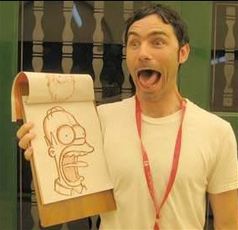Behind the scenes of Jewish animation
Published October 12, 2014
Max Fleischer, Fritz Feleng, Harvey Kurtzman and Sol Brodsky. While this may sound like a buzzfeed list ranking the best rabbis of the year, these men are in fact just a handful of the many historically important animators, who indeed happened to be Jewish. This little-known relationship between Jews and cartoons has sustained through the decades and Lucas Gray, director of animation for the hit series “Cosmos,” strives to publicize this legacy.
“I always loved drawing cartoons, but I never really thought of animation as a career,” said Gray, who currently lives in Santa Monica, Calif.
After graduating from Evergreen State College in Olympia, Wash., Gray decided to take an internship with the popular animated sitcom, “The Simpsons.” After just weeks, he had secured his position as a member of the storyboard and character design team. He would soon become one of Hollywood’s most desirable artists.
“I was offered a job working for ‘Family Guy,’” said Gray. “For the next few years, I bounced between both shows and a few others as well.”
By 2012, Lucas was a well established animator in California. He was soon asked to direct animation for the hit series, “Cosmos.” Although it proved to be a great experience, Lucas regrets that the series was way too short.
Along with being Jewish, Gray is also a proud member of the St. Louis community. “Almost all of my family lives there,” said Gray. “My frequent visits help inspire my work and encourage me to remain in this humorous business.”
Joking around with his Jewish family at annual Thanksgiving and Hannukah parties continues to foster his beloved passion, just like it did when he was a child.
“I always loved to color with the cousins,” said Gray, adding that cartoons and comedy acts he watched with them similarly inspired this dream.
The “Looney Toons” and “Marx Brothers” movies stood out most distinctly in his memory, and he admits that these still hold great influence over his work today. While Bugs Bunny and Groucho Marx may seem to come from different comedic planets, they were both in fact the work of Jewish humorists. Max Fleischer, creator of popular character, Betty Boop, stands as a prime example of an animation pioneer.
“Max was a Jewish immigrant, born in Krakau in 1883,” said Ginny Mahoney, official archivist for Fleischer studios and grandchild to this animation great. “He immigrated to the U.S when he was about 4 years old.”
After creating the Rotoscope, a method used to make animated movement seem more lucid and fluent, Fleischer and his brother Dave started their careers as animators for a large studio called Brash. As a new medium, animation was becoming increasingly popular. In fact, as soon as 1921, the brothers had already started their own animation studio titled, “Out of the Inkwell.” It would later become known as Fleischer Studios
“When they opened this new studio they had only one other employee,” said Mahoney. “By 1938, when they undertook the making of their first full-length animated film, ‘Gulliver Travels,’ the size of their staff had grown to over 750!”
Fleischer’s New York upbringing and lifestyle are obviously apparent in his cartoons. While other studios such as
Disney were located on the West Coast, Fleischer’s was one of few “East Coast studios”.
Where Californian animation had more of a “cutesy” and farm-like feel, Fleischer’s cartoons took place in dark, urban settings.
“The Fleischer East Coast animation can be very harsh, city-like, sometimes very surrealistic and even a little scary,” said Mahoney.
Along with the creation of such an iconic series as “Betty Boop”, “Popeye” and “Superman,” Fleischer changed the way that society forever viewed animation.
“When the new medium of film came along- including animation– there were many ideas about what this new medium might be used for,” Mahoney said. “One of the interesting uses that Max envisioned was that it could be used for educational purposes.”
Fleischer was among the first to create instructional videos for troops entering World War I, and later developed a movie explaining Einstein’s Theory of Relativity.
“[Fleischer] was a true animation pioneer,” said Mahoney. “I was very very fortunate to have known him really well.”
While from completely different eras, Gray and Fleischer have both contributed to this legacy of pioneering Jewish animators. Gray believes that while he may leave a large footprint in this history, he is certainly not the last member of the animating dynasty.
“I think everyone can be a great artist,” said Gray. “It’s those who invest time in learning this language of animation who succeed.”














